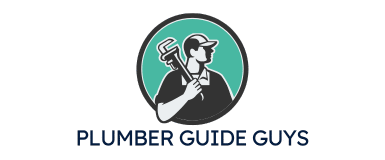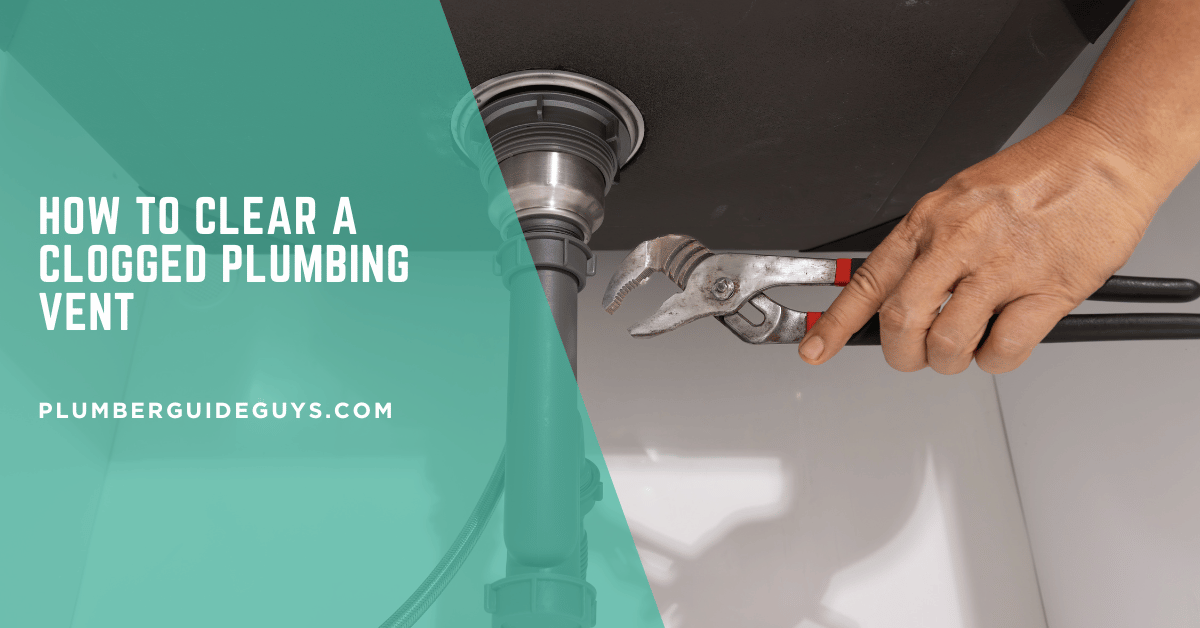Affiliate Disclosure
Plumber Guide Guys is a participant in the Amazon Services LLC Associates Program, an affiliate advertising program designed to provide a means for sites to earn advertising fees by advertising and linking to Amazon.
How to Clear a Clogged Plumbing Vent? Ever noticed your drains gurgling and toilets flushing slow? It might be a clogged plumbing vent above your head. This hidden problem can mess up your home’s drainage system.
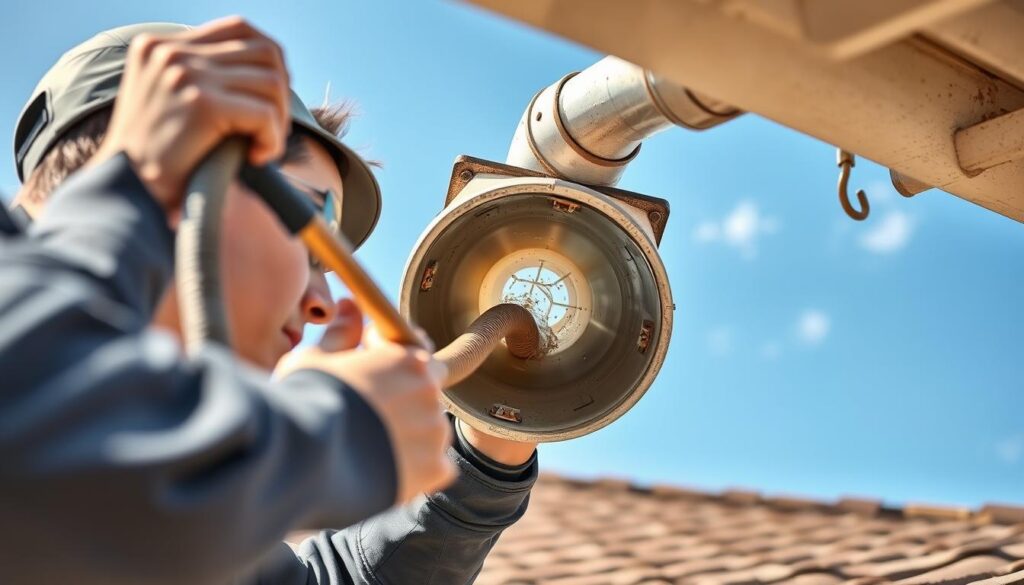
The plumbing vent, or stack, connects your plumbing to the roof. A blockage here can lead to many plumbing issues. Knowing how to clear a clogged vent can save you from costly repairs and headaches.
This guide will show you how to find, access, and fix vent blockages. You’ll learn to handle this common maintenance task.
Key Takeaways
- Plumbing vents are key for good drainage
- Blockages can cause many plumbing problems
- Clearing vents yourself is possible with the right tools and knowledge
- Regular maintenance can prevent big plumbing problems
- Always be careful when working on roof-based plumbing systems
Table of Contents
Understanding Plumbing Vent Systems and Their Function
Your home’s plumbing system is complex and needs regular care. Plumbing vents are key to keeping your drains working well. They help water flow smoothly and prevent problems.
At the heart of your plumbing, vents are air paths that control pressure. They prevent blockages by extending from your drains to the roof. This setup ensures your plumbing runs efficiently.
The Role of Air Pressure in Drain Systems
Water moving through pipes changes pressure. Without vents, these changes can harm water flow. Regular maintenance of plumbing vents manages these pressures.
- Allows air into the drainage system
- Keeps pipe pressure balanced
- Protects water seals in drain traps
How Plumbing Vents Prevent Vacuum Formation
Vacuum can hurt your plumbing’s efficiency. Plumbing vents are vital for controlling pressure. They stop vacuum that could slow down water flow and damage pipes.
Location and Basic Components of Vent Stacks
Vent stacks are placed for best air flow. They go up from your main pipes, through the roof, and above it. This ensures good ventilation.
Key parts of a vent system are the main stack, branch vents, and terminals. Keeping vents in good shape helps avoid big problems.
Common Signs of a Clogged Plumbing Vent
Spotting a clogged plumbing vent early can save you from big repair costs and health risks. Your plumbing system sends out warning signs when something’s amiss with the vent stack.
Here are the key signs of a clogged plumbing vent to watch for:
- Unusual Gurgling Sounds: Persistent gurgling from sinks, bathtubs, or toilets when water drains
- Slow Drainage: Multiple fixtures draining unusually slowly or backing up
- Foul Odors: Persistent sewer-like or rotten egg smell in bathrooms or kitchens
Knowing these symptoms helps you catch vent blockages early. If you ignore these signs, you might face bigger plumbing problems and damage to your home’s drainage system.
| Sign | Potential Indication | Recommended Action |
|---|---|---|
| Gurgling Sounds | Air pressure disruption in vent | Inspect vent stack for blockages |
| Slow Drainage | Partial vent obstruction | Check for debris or animal nests |
| Sewer Odors | Blocked vent preventing proper air circulation | Clean or clear vent opening |
“Early detection of plumbing vent issues can prevent expensive repairs and maintain your home’s drainage efficiency.” – Professional Plumbing Association
If you see several signs of a clogged plumbing vent, it’s important to check or call a professional plumber. They can assess and fix the problem fast.
Essential Tools and Safety Equipment for Vent Cleaning
Getting ready for plumbing vent pipe cleaning needs careful planning and the right tools. Before starting, make sure you have all the necessary equipment. This is key for a safe and successful maintenance job.
Being well-prepared makes your cleaning job more effective and safer. Experts say to have a full toolkit ready before you begin any roof or vent work.
Required Tools and Materials
- Plumber’s snake (auger)
- Flashlight with extra batteries
- Garden hose
- Protective drop cloth
- Drain cleaning solution
- Rubber gloves
- Wire brush
Safety Gear and Precautions
Your safety is most important when cleaning plumbing vents. Wearing the right protective gear can prevent accidents and make the job smoother.
- Non-slip rubber-soled shoes
- Safety harness
- Hard hat
- Safety glasses
- Dust mask
Roof Access Equipment
Getting to your roof safely is vital for effective cleaning. The right tools help you avoid hazards and do the job well.
- Sturdy extension ladder
- Ladder stabilizer
- Roof brackets
- Non-slip ladder shoes
- Roof harness attachment point
Pro Tip: Always have a helper present when working on roof-related maintenance to provide additional safety and assistance.
How to Clear a Clogged Plumbing Vent: Step-by-Step Guide
Clearing a clogged plumbing vent can save you from drainage issues and expensive repairs. You’ll need patience and the right approach to do it.
First, gather your essential tools for unclogging the roof vent:
- Plumber’s snake
- Garden hose
- Protective gloves
- Safety glasses
- Flashlight
Start by finding the roof vent stack. It’s a pipe through your roof, near bathrooms or kitchens. Make sure you have safety gear before climbing up.
Look for debris like leaves, twigs, or animal nests at the vent opening. Remove any visible obstructions carefully. Wear protective gloves to prevent injury.
Then, use a plumber’s snake to tackle deeper blockages. Insert the snake into the vent pipe and push through any resistance. Rotate it to break up clogs and remove debris.
Flush the vent with a garden hose to check if it’s clear. Look for water flowing well through your home’s drains. If water backs up or drains slowly, you might need more cleaning or help from a pro.
Pro Tip: Regular maintenance can prevent future plumbing vent clogs and save you from costly repairs.
Accessing Your Roof Vent Stack Safely
Cleaning a roof plumbing vent needs careful preparation and safety steps. Knowing how to access your roof safely is key to avoid accidents and injuries.
When working on roof plumbing vents, safety comes first. Roofers suggest several important steps to keep you safe during this task.
Ladder Placement Strategies
- Choose a strong, fiberglass or aluminum extension ladder
- Put the ladder on solid, level ground
- Make sure the ladder goes 3 feet above the roof edge
- Keep a 4:1 angle ratio (4 feet out for every 1 foot up)
Weather Considerations
Weather affects roof safety a lot. Don’t go on the roof when it’s wet, icy, or windy. These conditions make it easy to slip.
| Weather Condition | Safety Risk Level | Recommended Action |
|---|---|---|
| Wet Surface | High Risk | Postpone Maintenance |
| Strong Winds | Extreme Risk | Do Not Attempt |
| Clear, Dry Day | Low Risk | Proceed with Caution |
Safety Harness Essentials
On steep or high roofs, a safety harness is essential. Pick a harness rated for roofing and always tie off to a solid roof point.
- Wear non-slip, rubber-soled shoes
- Use a full-body safety harness
- Have a spotter or assistant present
- Keep tools secured to prevent dropping
Using a Plumber’s Snake for Vent Cleaning
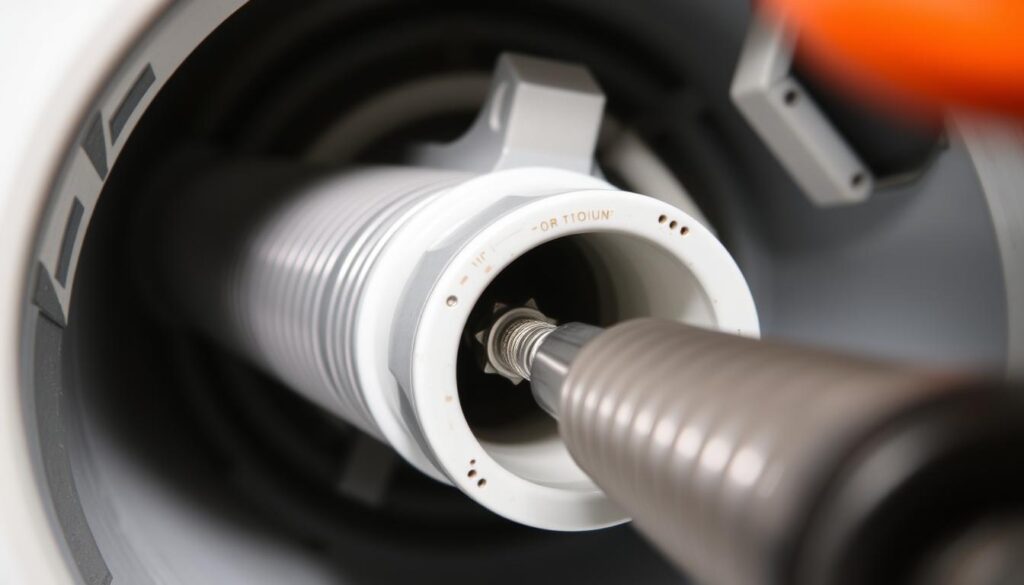
Clearing a blocked plumbing vent pipe needs skill and the right tool: a plumber’s snake. This tool helps you get through tough pipe blockages. It makes sure your home’s plumbing system gets the air it needs.
When picking a plumber’s snake, choose the right one for your job. Experts say to go for flexible cable snakes with various lengths and attachments.
- Choose a snake with 25-50 feet of cable
- Select a flexible cable with a rotating mechanism
- Use protective gloves and eye gear
- Ensure ladder stability before roof access
The snake works by physically breaking through and removing obstructions in your plumbing vent pipe. Feed the snake down the vent stack gently. This helps you get through blockages like leaves, debris, or small animal nests.
| Snake Type | Best Used For | Cable Length |
|---|---|---|
| Manual Plumber’s Snake | Small residential vent clogs | 25-30 feet |
| Power Auger Snake | Stubborn or deep blockages | 50-100 feet |
| Motorized Drain Snake | Complex plumbing vent systems | 75-150 feet |
Professional plumbers say to be careful with a snake. Stop right away if you feel a lot of resistance. This could damage your vent pipe. If unsure, call a pro who knows how to clean plumbing vent pipes.
Alternative Methods for Clearing Stubborn Blockages
When traditional snaking methods don’t work, you need new ways to clear blocked sewer vents. Clogs that won’t budge need creative solutions.
Professional plumbers suggest two effective methods for tough vent blockages:
Garden Hose Flushing Method
The garden hose technique is a strong way to clear blocked sewer vents. Here’s how to do it:
- Make sure your roof access is safe and secure
- Remove the vent cap carefully
- Insert a garden hose with moderate water pressure
- Flush the vent stack thoroughly
- Watch for debris being pushed out
Caution: Use steady, controlled water pressure to avoid damaging your plumbing system.
Professional Chemical Solutions
When mechanical methods fail, chemical treatments can help. These solutions break down tough clogs and organic materials.
- Select enzymatic drain cleaners
- Use specialized vent-clearing chemical solutions
- Follow manufacturer instructions precisely
- Wear protective gear during application
Clearing blocked sewer vents needs patience and the right approach. If these methods don’t work, it’s time to call a professional plumber.
Indoor Vent Cleaning Methods Through the Attic
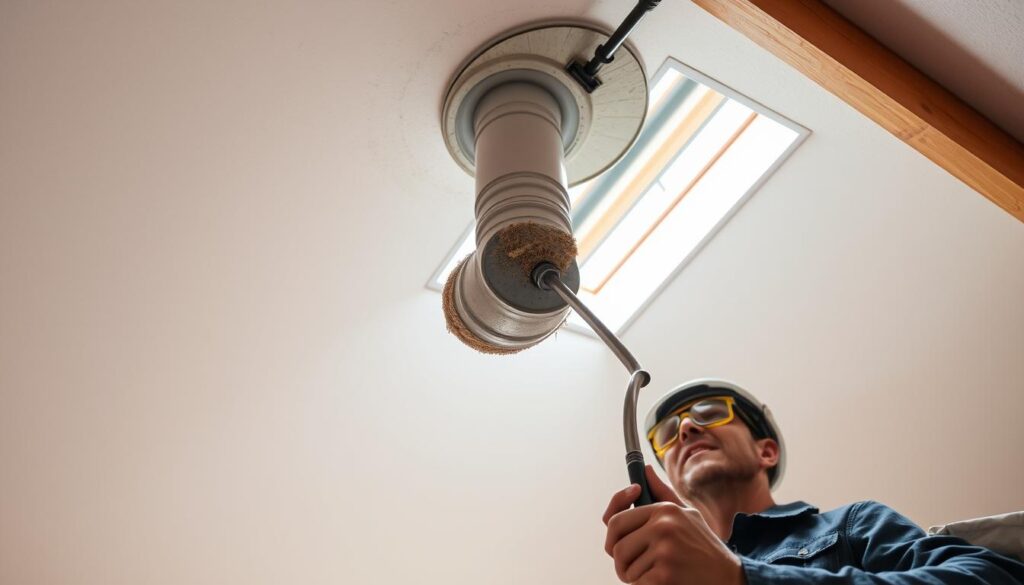
Cleaning your plumbing vent pipe from inside the attic is a good option when getting to the roof is hard. This method is safe and works well to keep your drainage system running right.
Before you start cleaning the plumbing vent pipe, make sure you have these tools:
- Protective safety gear
- Plumber’s snake
- Flashlight
- Reciprocating saw
- Replacement PVC pipe section
First, find the vent pipe in your attic. It’s important to know where it is. Look for the vertical pipe that connects to your home’s bathroom or kitchen drainage.
Here’s how to clean the indoor plumbing vent pipe:
- Check the vent pipe for any blockages
- Use a flashlight to see inside the pipe
- Cut a section of the PVC pipe carefully
- Put a plumber’s snake into the opening
- Slowly push the snake through the pipe to clear out debris
Remember, safety is key. Always wear protective eyewear, gloves, and a dust mask to avoid injuries or exposure to harmful substances.
| Cleaning Method | Difficulty Level | Time Required |
|---|---|---|
| Manual Snake Cleaning | Moderate | 1-2 hours |
| Professional Inspection | Low | 30-45 minutes |
Once you’ve cleaned the pipe, put the PVC section back and seal it well. If you find it hard or are not sure, it’s best to call a professional plumber. They can help avoid damage to your plumbing system.
Preventing Future Plumbing Vent Clogs
To keep your home’s plumbing vent system working well, you need to take care of it. By doing regular maintenance and planning ahead, you can avoid many problems. This way, you can also stop blockages before they start.
Keeping your plumbing vent system clean is key. You should protect it fully and catch any issues early.
Strategic Maintenance Practices
- Do annual checks on your roof vents
- Trim trees close to your roof to stop debris
- Keep the roof area around vents clean
- Look for any blockages in the vent stack openings
Debris and Wildlife Management
Having trees too close to your vents can be a problem. Cut branches within 10 feet of your roof. This stops leaves, twigs, and animals from clogging the vents.
| Potential Blockage Source | Prevention Strategy |
|---|---|
| Leaves and Branches | Regular tree trimming |
| Small Animals | Install protective vent covers |
| Debris Accumulation | Annual professional inspection |
Proper Vent Cap Installation
Getting the right vent caps is important for keeping vents clear. Look for caps that:
- Let air flow well
- Keep out debris and animals
- Can handle your local weather
- Fit your vent pipe size
Getting advice from a pro can help you pick the best vent cap for your home.
Conclusion
Knowing how to clear a clogged plumbing vent is key to keeping your home’s plumbing system safe. The methods you’ve learned help you find, fix, and prevent vent blockages. These blockages can mess up your home’s drainage.
Start by regularly checking your plumbing and acting fast if you see signs of a clog. You can use a plumber’s snake, a garden hose, or professional tools to fix most problems. This way, you can handle most vent blockage issues safely and well.
It’s also vital to prevent future clogs. Regular roof upkeep, trimming trees, and using the right vent caps can help a lot. These steps can lower the chance of blockages. By doing this, you’ll keep your plumbing system in good shape and avoid expensive fixes.
Your home’s plumbing system needs ongoing care. With the right tools, knowledge, and upkeep, you can keep drainage smooth. This helps keep your daily life running smoothly without interruptions.
